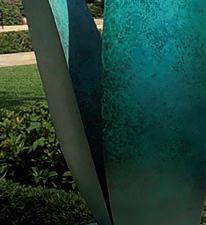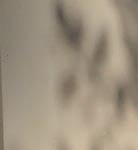WALKING TOUR





Welcome to The Society of the Four Arts! The Four Arts was originally founded in 1934 as the Civic Arts Association. In 1936, the organization changed its name to ‘The Society of the Four Arts’ and incorporated as a nonprofit with a mission to promote art, literature, music, and drama. The Four Arts has grown immensely over the years and is now Palm Beach’s preeminent cultural institution, o ering a diverse array of programming such as concerts, films, art exhibitions, notable speakers, workshops, classes, and children’s programs.
This walking tour guides visitors around The Four Arts’ 10-acre campus, which includes the Philip Hulitar Sculpture Garden, The Four Arts’ Botanical Gardens, and its historic landmark buildings. It also provides information about the people and events that have shaped the organization’s history.
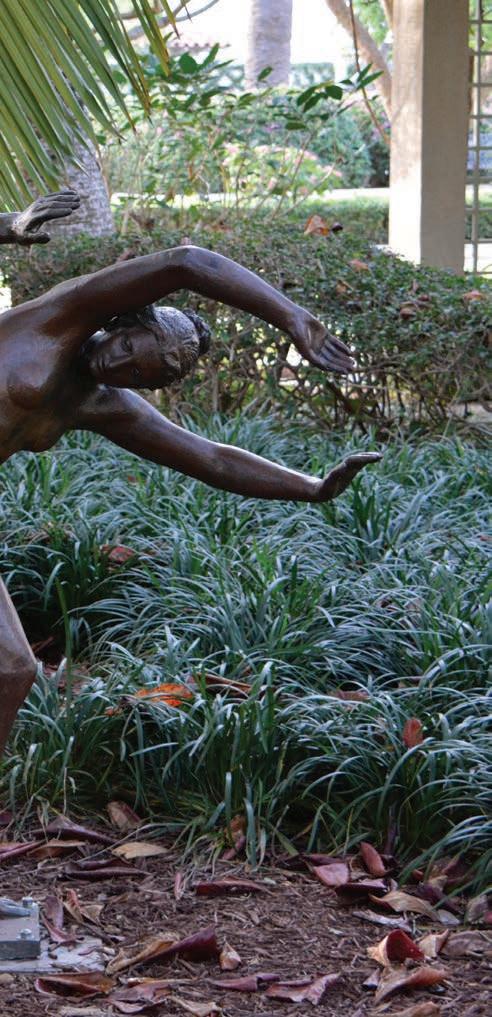
We welcome and encourage you to take informal photos with personal mobile devices or cameras. However, permits are required for all third-party, professional, or formal photos. For a photo permit, please go to www.fourarts.org/faq. Note that videography, commercial photography, or additional equipment (ladders, lights, clothes racks) besides professional cameras are not permitted.
Bicycles & skateboards
Non-Four Arts events
Wedding ceremonies
Wedding receptions
Pets – except for leashed service dogs
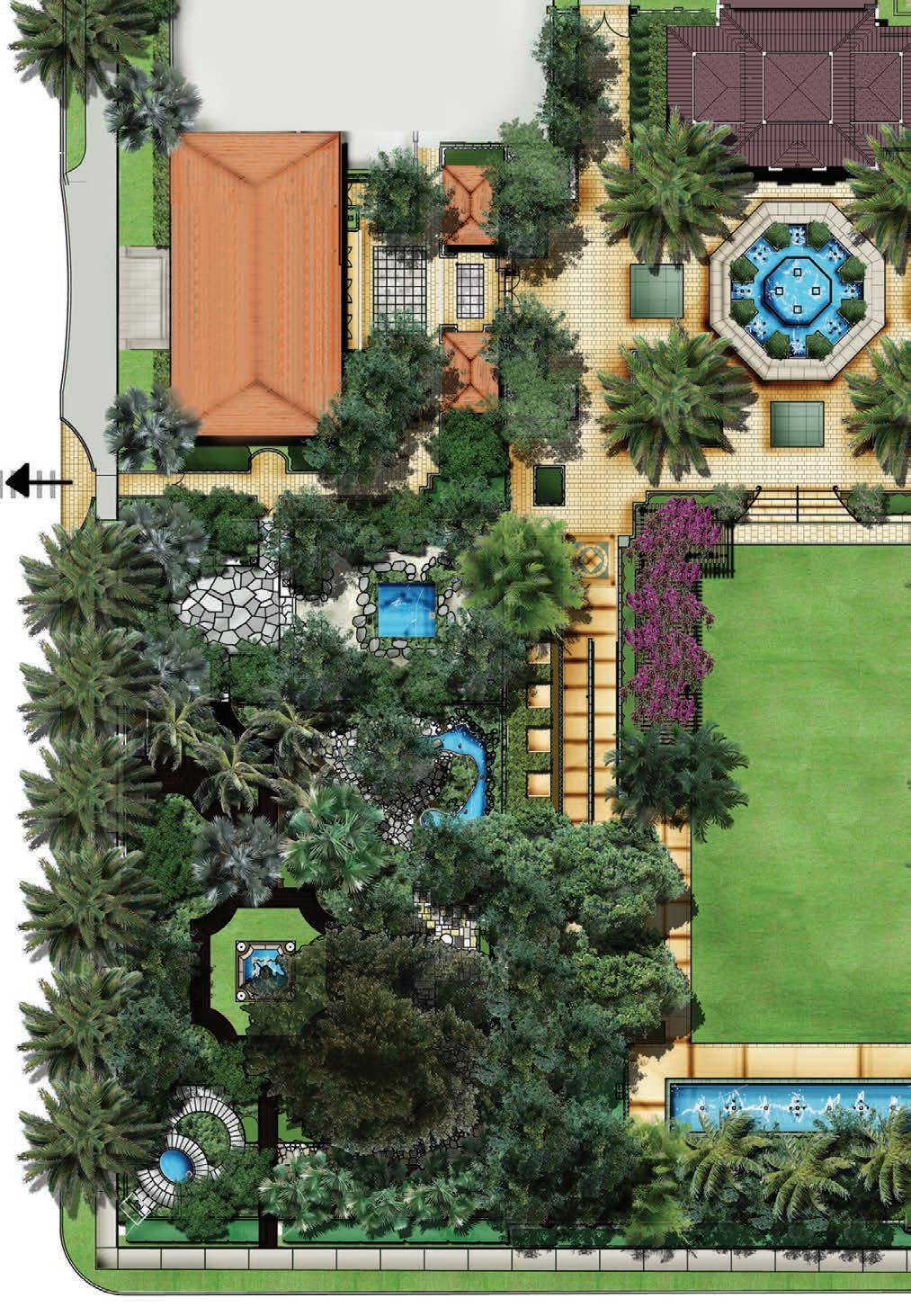
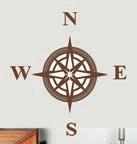

In 1937, The Four Arts hired Swiss-born American architect Maurice Fatio (1897–1943) to design the first building to house The Society of the Four Arts. Upon its opening on January 8, 1938, it was used for lectures, concerts, art exhibitions, children’s programs, a library, and sta o ices, but today serves as The Four Arts’ library. In 1996 it was named in honor of Giaconda and Joseph King, who were generous donors. The most famous part of the building is the west loggia, where murals depicting personifications of art, literature, drama, and music painted in 1939 by American artist Albert Herter (1871-1950) adorn the walls. Over time, the murals deteriorated, and local painter Zenon Toczek recreated them in 2018 at the same time the entire building underwent a major restoration.

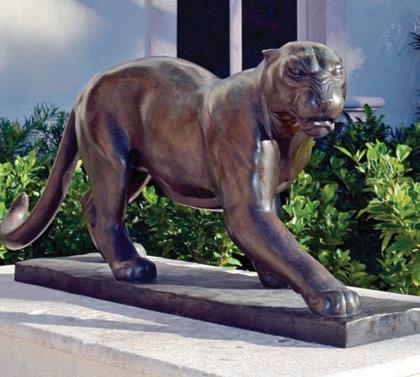
GIFT OF ANDREW JERGENS AND BYRON D. MILLER COLLECTION OF THE SOCIETY OF THE FOUR ARTS, 1970.34
American artist Wheeler Williams (1897–1972), who trained in Chicago, Yale University, and the École des Beaux-Arts in Paris, was an accomplished maker of public monuments and architectural decoration. For example, his high relief allegory of Commerce and Communications fills the pediment of the Environmental Protection Agency Building (1935) in Washington, D.C. Two years later Williams received a medal at the Universal Exposition in Paris. He modeled these life-sized, highly realistic panthers in his studio in Hollywood, California. They originally had an unusual patina—oxidized silver-plated bronze—to make the surface of the sculptures dark and opaque. The cat’s eyes were lacquered green. The panthers recall similar sculptures by Italian artist Rembrandt Bugatti.

COLLECTION OF THE SOCIETY OF THE FOUR ARTS, 2013.2
Forgotten World III is from a series of paintings and sculptures that American artist Norman Sunshine (b. 1935) created in 2006. The series, also titled Forgotten World, explores the friction between chaos and order. In Forgotten World III, the carefully balanced shapes and forms symbolize how everyday world events can easily spin out of control and into disorder. Originally born and raised in California, Sunshine now divides his time between Connecticut and West Palm Beach, Florida.
Welcome to The Four Arts’ Botanical Gardens. Originally planted in 1938 by members of the Garden Club of Palm Beach, many of whom were members of The Four Arts, the Botanical Gardens were designed as demonstration gardens to educate residents about plants that thrive in the South Florida climate. Garden club members divided the space into thematic sections and selected plants, sculptures, and architectural features for each unique setting: Chinese garden by Mrs. Lorenzo Woodhouse, Italian garden by Mrs. Joseph Cudahy, Moonlight garden by Mrs. Joseph F. Gunster, Bermuda style English garden by Mrs. Cli ord V. Brokaw, Rose garden by Mrs. Hugh Dillman, Jungle garden by Dr. Leroy Dow, Madonna tropical fruit garden by Mrs. Alfred G. Kay, and a Spanish Patio built by Mrs. John S. Phipps. These enchanted gardens continue to teach residents and visitors today and are maintained by the Garden Club of Palm beach. To learn more, please visit: https://gardenclubpalmbeach.com/.

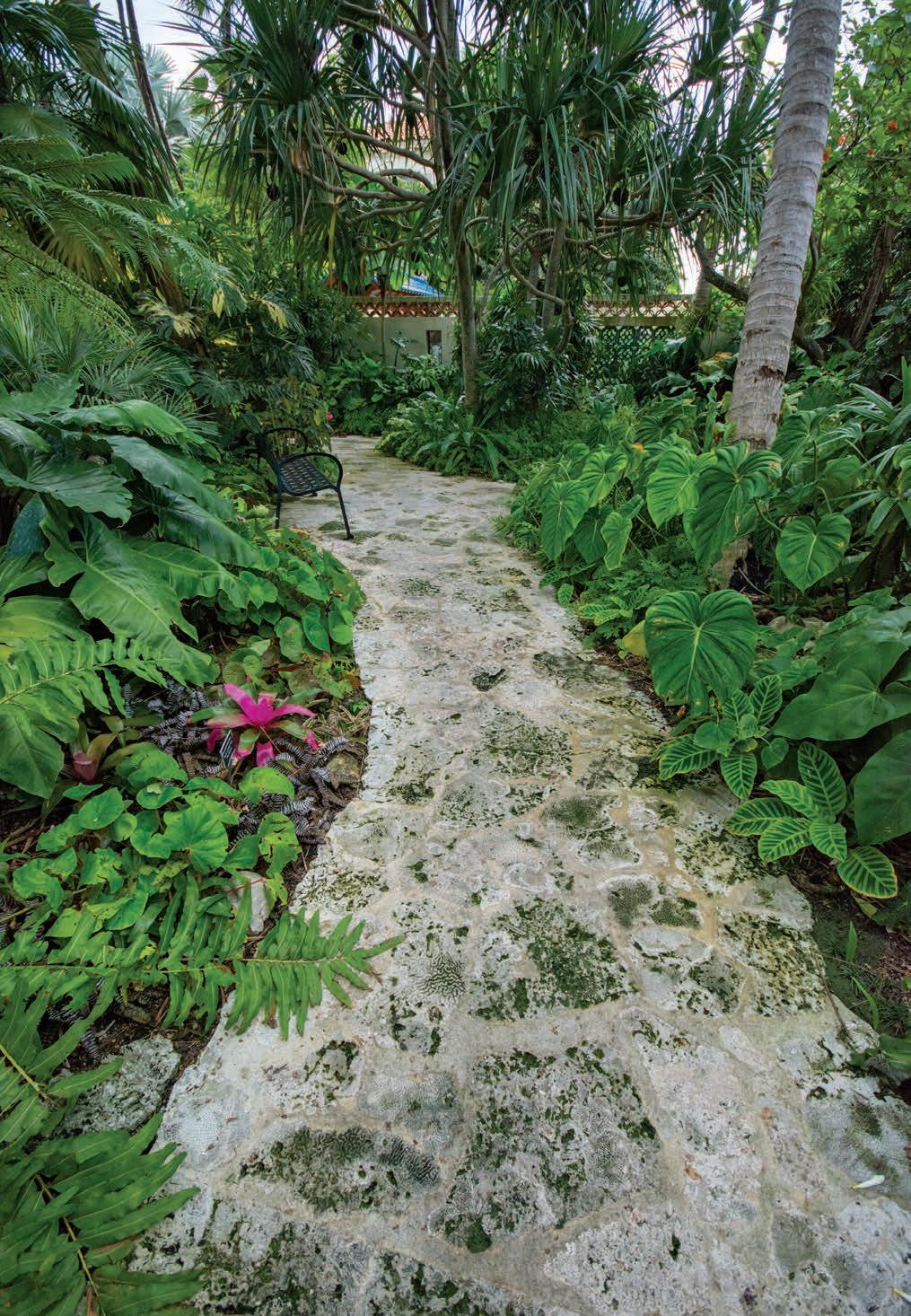
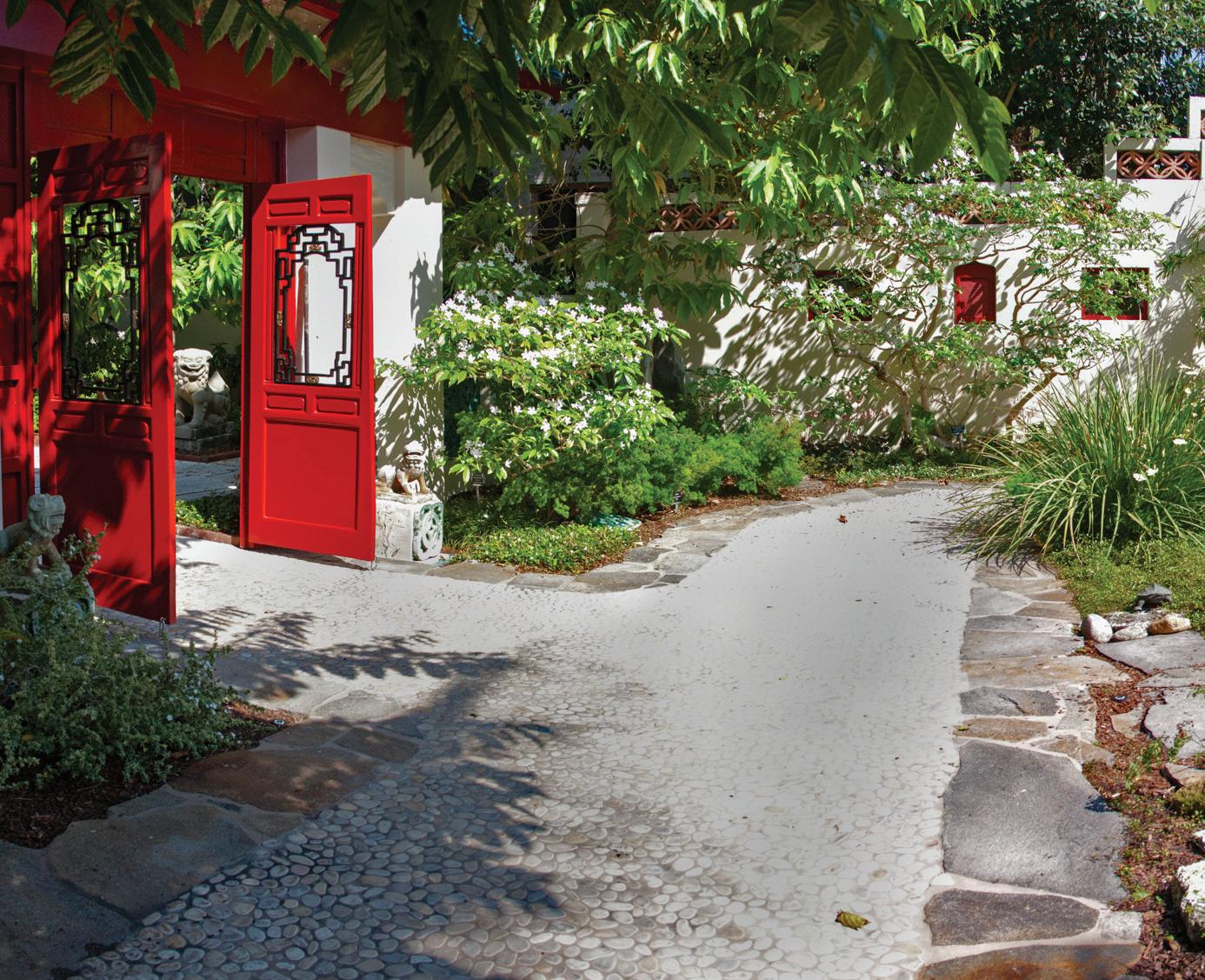

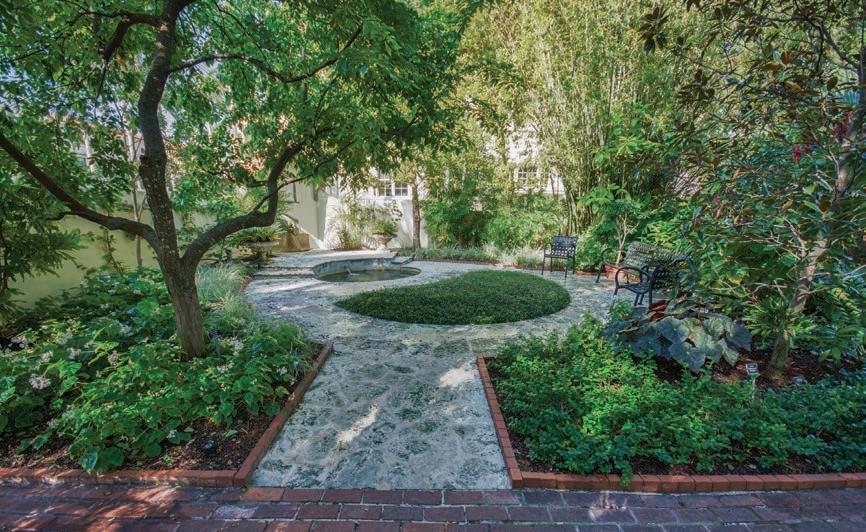
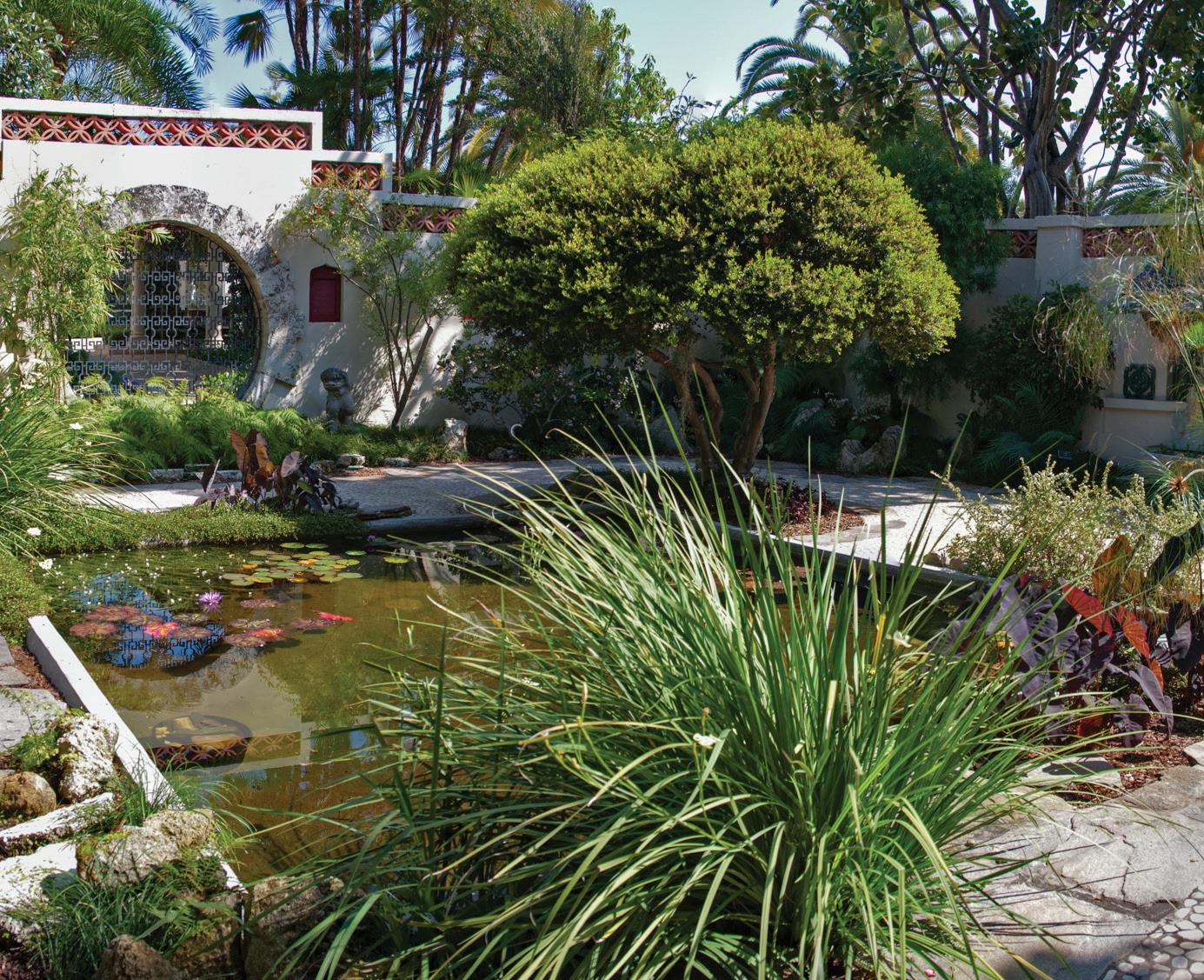

Peacock Monument, 2004 Bronze
GIFT OF MR. AND MRS. FITZ EUGENE DIXON, JR. COLLECTION OF THE SOCIETY OF THE FOUR ARTS, 2006.2.1-.2
American sculptor Dan Ostermiller (b. 1956), a former president of the National Sculpture Society of America, is based in Colorado. He specializes in animals, both wild and domestic, in the tradition of the 19th-century French animaliers such as Antoine-Louis Barye (but without Barye’s savagery). He developed his understanding of animal forms from his father Roy, who was a renowned taxidermist. Monumental on tall square columns, this pair of noble peacocks celebrate the entrance to the Philip Hulitar Sculpture Garden.
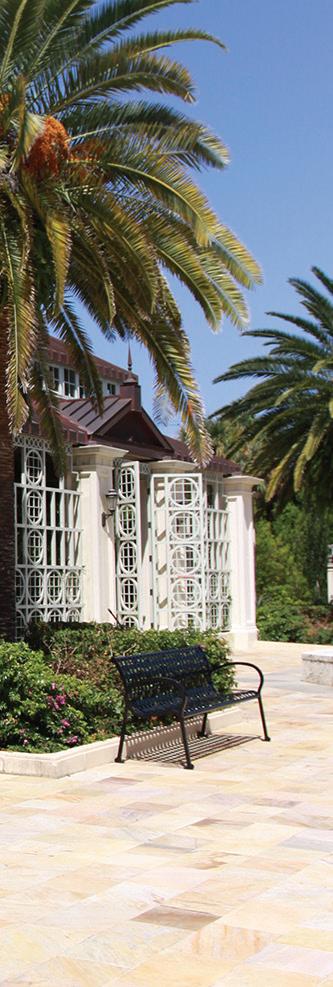
The Four Arts acquired this two-and-a-half-acre expanse of land in the mid 1960s. It remained unkempt and neglected until 1979 when Four Arts member Mrs. John Cli ord Folger asked Philip Hulitar, a fashion designer and former Four Arts’ Chairman of the Board, to transform the undeveloped space into a sculpture garden. Not only did he design the space, he also helped acquire sculptures for it. The garden opened in November of 1980 and was o icially named the Philip Hulitar Sculpture Garden in 1988 in recognition of his continued support for the space. Following a series of devastating hurricanes in the mid 2000s, The Four Arts hired the landscape architecture firm Morgan Wheelock, Inc. to reimagine the garden by adding walkways, fountains, and gallery-like settings for the display of sculpture.
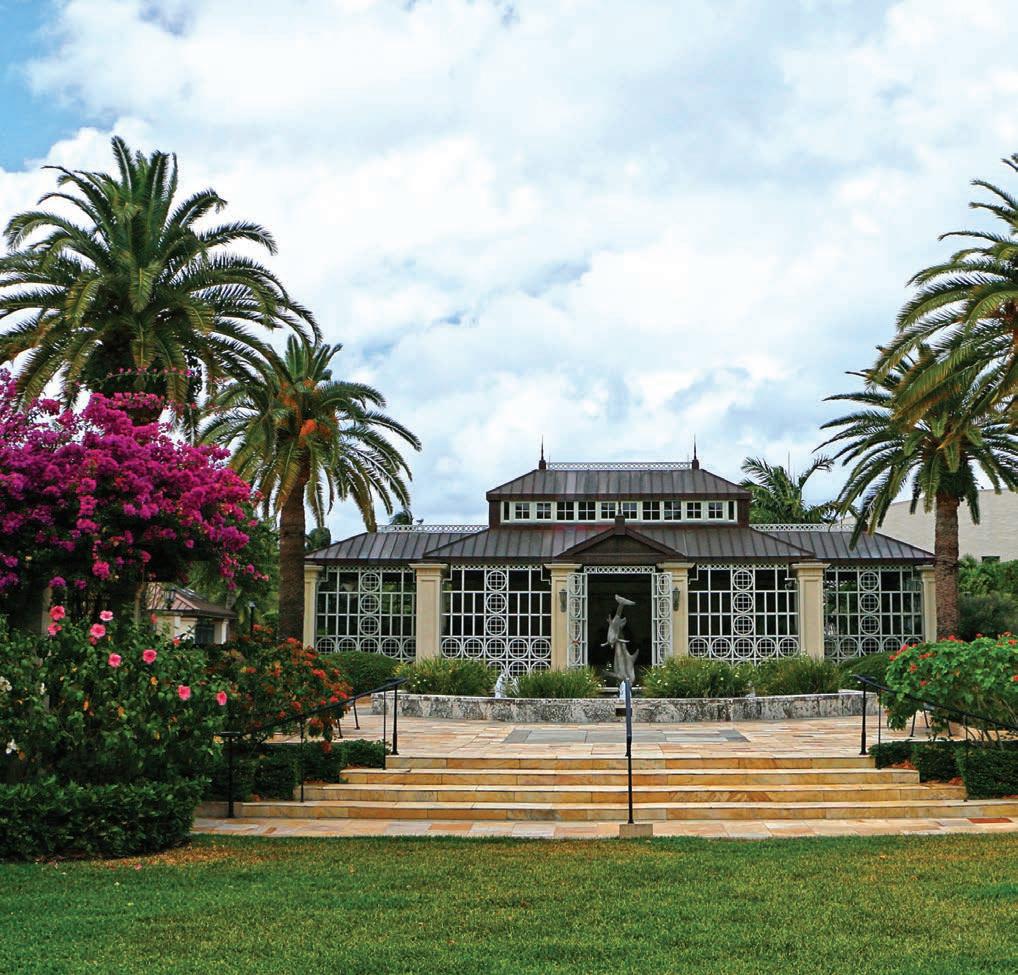
7
GIFT OF ZITA HAWLEY
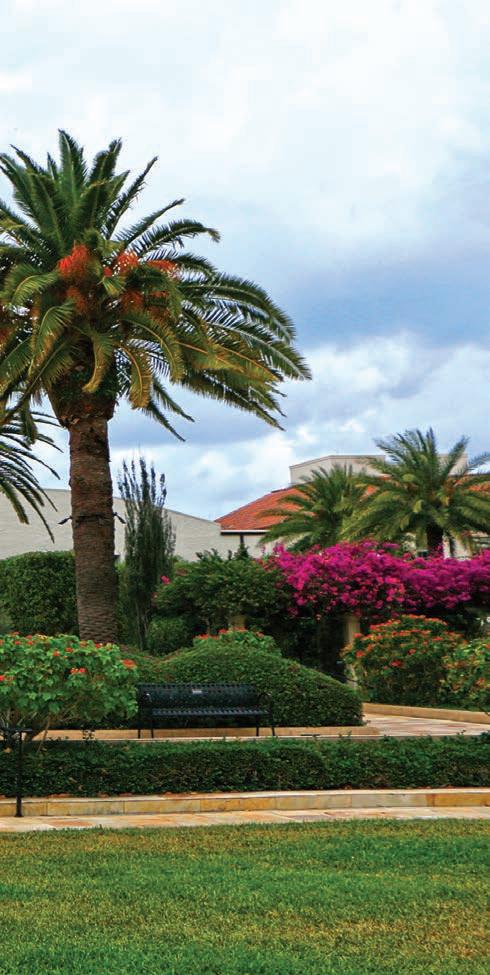
OF THE SOCIETY OF THE FOUR ARTS, 2010.1
The Bond is a life-size sculpture depict ing a dolphin and her calf. Created by American artist David H. Turner (b. 1961), who learned to cast sculptures from his father William H. Turner, the realistic pair illustrates the strong familial social bonds dolphins form while living in pods. Turner has a passion for capturing the beauty and motion of animals in bronze. Born and raised on the eastern shore of Virginia, he finds inspiration in the rich wildlife of the Chesapeake Bay and the Atlantic Ocean.
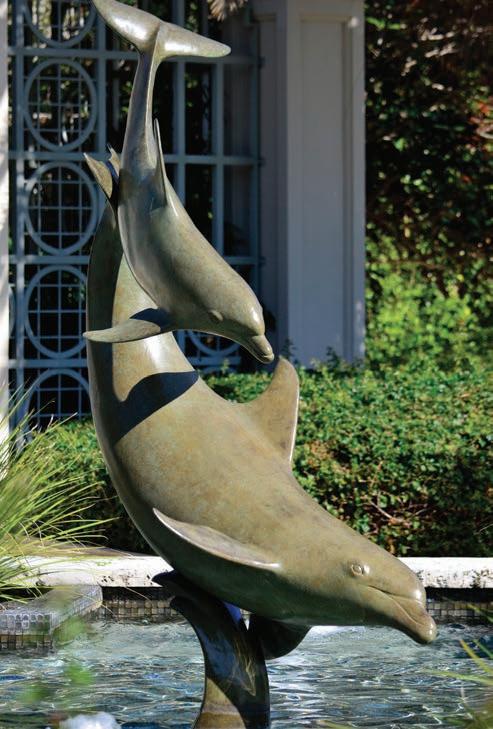
The Four Arts added this garden pavilion, designed by Giacomelli Architecture, Inc. of Lake Worth, Florida, to the Sculpture Garden in 2005. It is named for Mr. and Mrs. William G. Pannill who sponsored the project. Modeled on classical garden pavilions and designed in the iconic Florida Mediterranean style, the pavilion is a popular gathering and meeting space. It also includes an important water feature found throughout the garden. Fountains are strategically placed to provide the calm and soothing sound of running water.

Monumental Apple Basket, 1998 | Bronze

GIFT OF MARY HULITAR COLLECTION OF THE SOCIETY OF THE FOUR ARTS, 1998.1
Pear Harvest, 2008 | Bronze
GIFT OF JEANNIE AND RICHARD PEARMAN IN MEMORY OF THEIR PARENTS COLLECTION OF THE SOCIETY OF THE FOUR ARTS, 2008.1
Monumental Apple Basket and Pear Harvest are located inside the Pannill Pavilion. Created by the Spanish and American duo Luis Montoya (b. 1950) and Leslie Ortiz (b. 1957), the hyper realistic sculptures are part of their series Culinary Adventures, which depicts oversized representations of common fruits and vegetables. Montoya and Ortiz have been collaborating since 1994. Together they oversee every phase of their creation process from design and modeling to casting and patination.
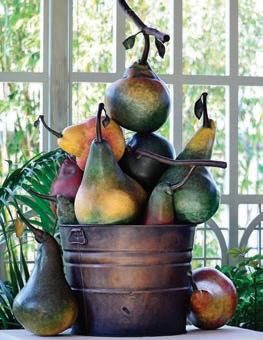
The Allies, 1992 | Bronze and Wood
ACQUIRED THANKS TO THE GENEROSITY OF MR. AND MRS. RANDALL D. SMITH AND OTHER DONORS COLLECTION OF THE SOCIETY OF THE FOUR ARTS, 2014.2
Allies, made by American-British sculptor, poet, lyricist, playwright, novelist, actor, and director Lawrence Holofcener (1926–2017), is the most popular sculpture in the Sculpture Garden. The life-sized portraits depicts former American President Franklin D. Roosevelt and former British Prime Minister Sir Winston Churchill in a relaxed conversation while seated on a bench. The original sculpture, which Princess Margaret unveiled in 1995 to commemorate 50 years of peace since World War II, is permanently displayed on Bond Street in London. This is one of only six other casts the artist made. Allies is an approachable sculpture, with the space in between the two leaders open for visitors to occupy. We invite you to sit here and pose for pictures.
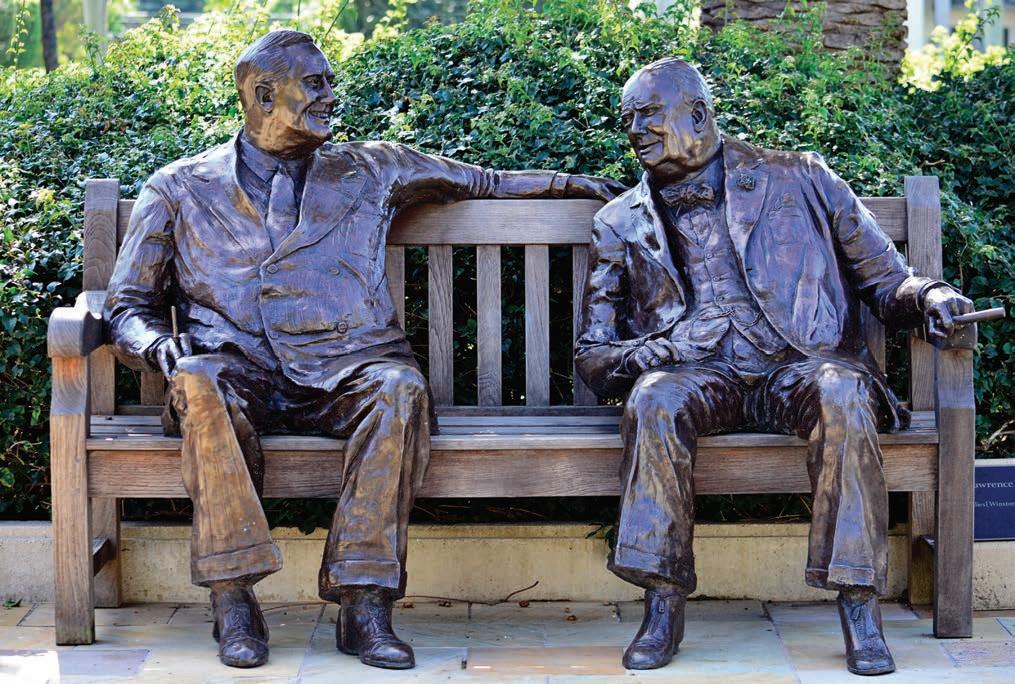
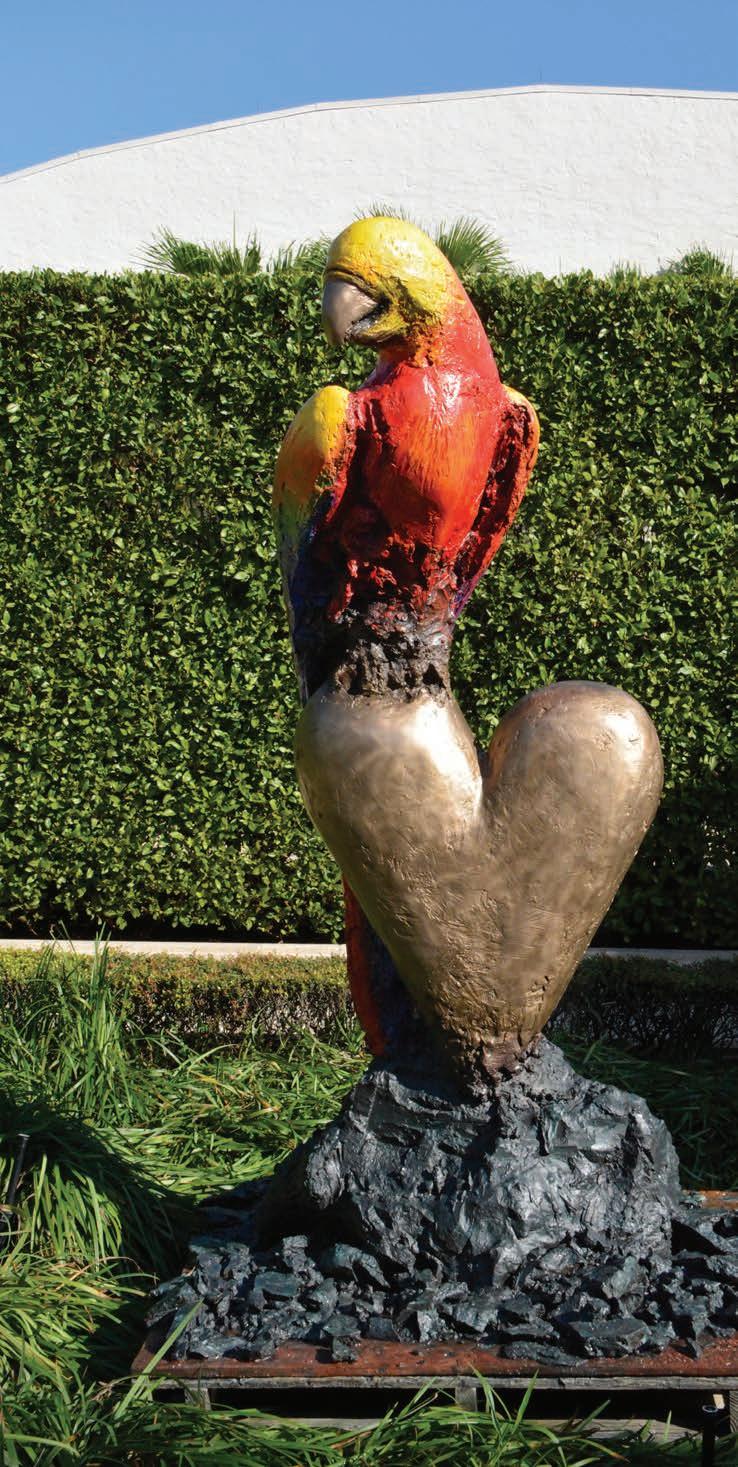
COLLECTION OF THE SOCIETY OF THE FOUR ARTS, 2014.1
The motif of the heart in the work of American artist Jim Dine (b. 1935) dates to 1966 when he made his earliest major sculpture, Nancy and I at Ithaca (Straw Heart). According to curator John Gordon, his hearts are “touching and powerful, full of joy and a ection.” This is poignant, given that Mary Tremaine Hildt donated King Parrot to The Four Arts to commemorate her late son. The parrot is a scarlet macaw from the Amazon, where indigenous peoples believe the bird is associated with transmigration, or the passage of a soul after death into another body.
ACQUIRED THANKS TO THE GENEROSITY OF THE CORNELIA T. BAILEY FOUNDATION AND OF ALBERTO AND GIOIETTA VITALE IN HONOR OF BEVERLY AND BILL PEPPER AND PHILIP AND JANE RYLANDS
COLLECTION OF THE SOCIETY OF THE FOUR ARTS, 2021.1
Beverly Pepper (American, 1922–2020) was the only woman sculptor of her generation to work in steel. She adopted the medium of Cor-ten around 1970. Crispina Senior II presents a single majestic curve of tapering steel that has the purely sculptural quality of 360-degree viewpoints. It appears slender and linear from some angles but substantial and planar from others. The sculpture also has an unusual textural quality of a seemingly corroded surface, which was an invention of the artist. Crispina Senior II was fabricated in Italy in an ironworks near Pepper’s life-long home in Todi.
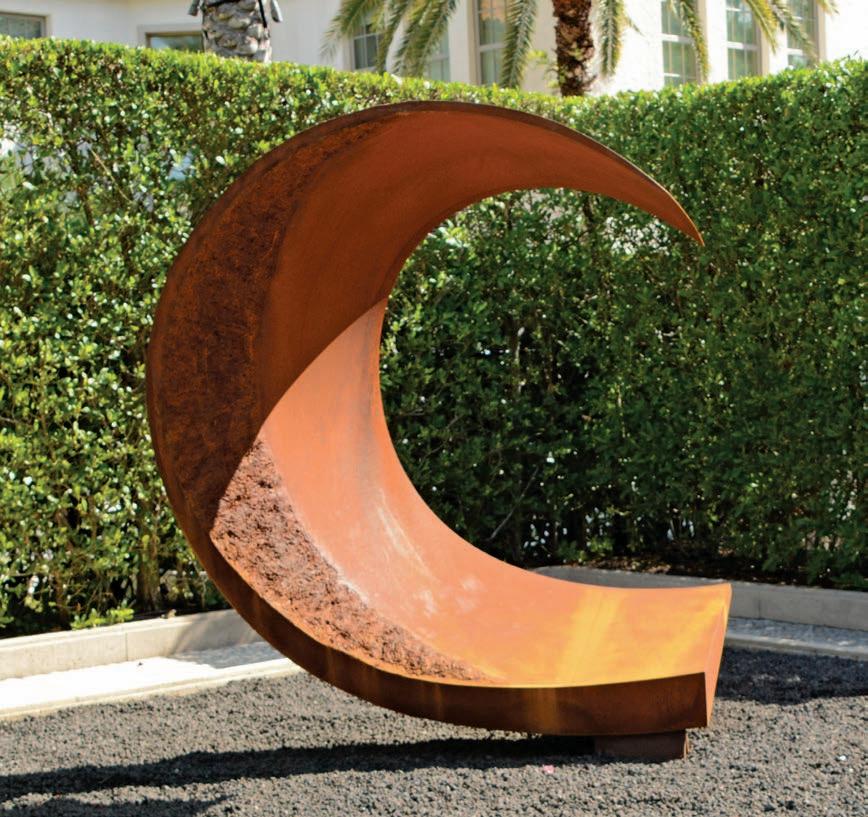
NORTH PERGOLA
DONATED BY GEORGE G. MATTHEWS AND BETSY K. MATTHEWS
EAST PERGOLA
DONATED IN HONOR OF JESSIE ARASKOG
SOUTH PERGOLA
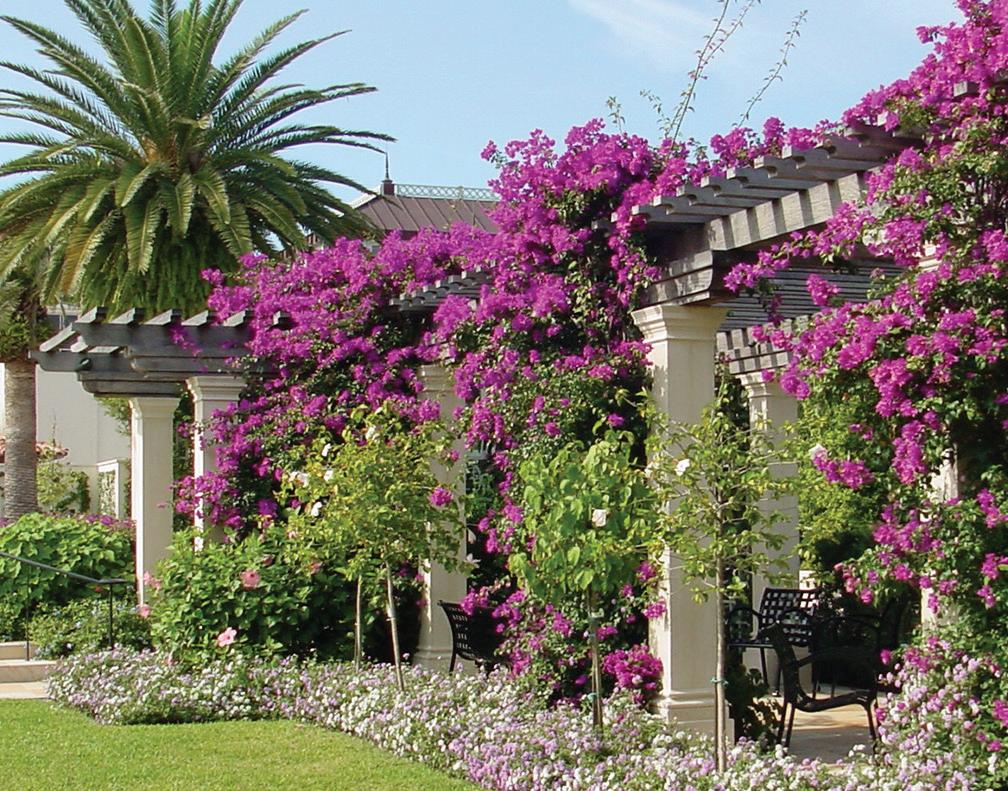
DONATED BY MERRIYLN BARDES AND HER SONS THOMAS H. QUINN, JR., ANDREW B. QUINN, AND OLIVER H. QUINN
WEST PERGOLA
GIFT OF PAGE LEE HUFTY BELL
The Sculpture Garden is adorned with four pergolas. A pergola is a garden structure consisting of vertical posts topped by cross beams and an open lattice framework. The stone columns of these pergolas support custom milled beams of Bolivian Ipe, also known as Ironwood because of its extreme durability. The north pergola was donated by George G. Matthews and Betsy K. Matthews; the east pergola was donated in honor of Jessie Araskog; the south pergola was donated by Merrilyn Bardes and her sons Thomas H. Quinn, Jr., Andrew B. Quinn, and Oliver H. Quinn; and the west pergola was donated by Page Lee Hufty Bell.
Located to the north of the Sculpture Garden is the Fitz Eugene Dixon Education Building. Originally constructed in the 1920s as the Palm Beach Public School, The Four Arts acquired the landmark property in 2010. It is named in honor of Fitz Eugene Dixon, Jr., a former chairman of The Four Arts who oversaw a period of great expansion, including the acquisitions of the Palm Beach Public School and the Rovensky Building and renovation of the Sculpture Garden. After a period of renovation that preserved the school’s exterior while modernizing its interior, the building opened in 2013 as the new home of the Campus on the Lake (COL). COL o ers a variety of cultural education programs that explore art, drama, literature, and music, and the art of living well. Please visit https://www.fourarts.org/campusonthelakeprograms to learn more.
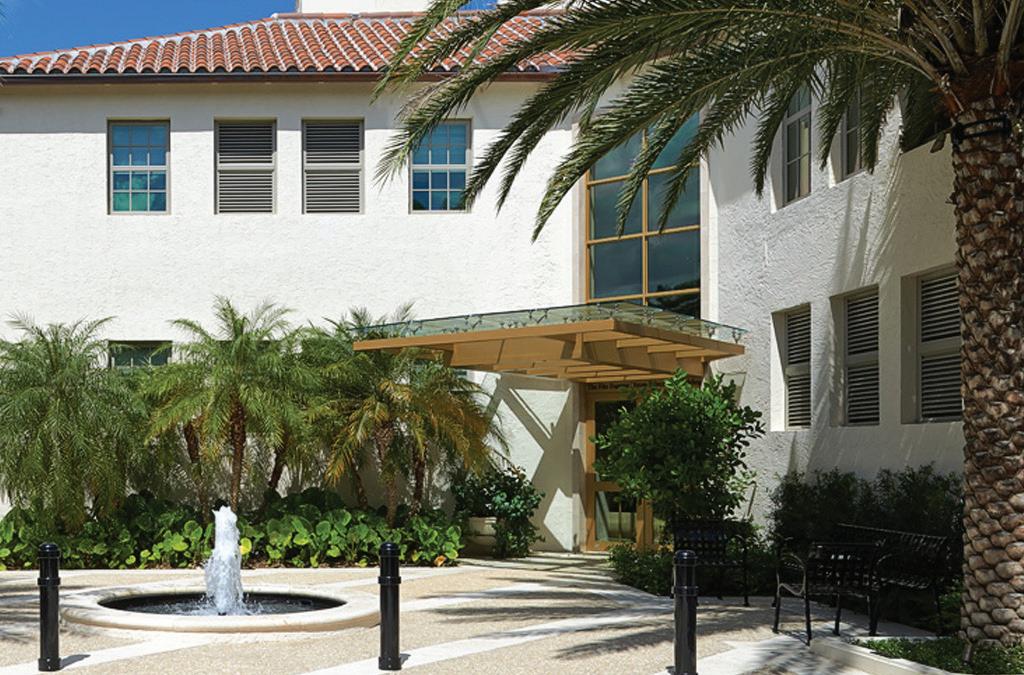
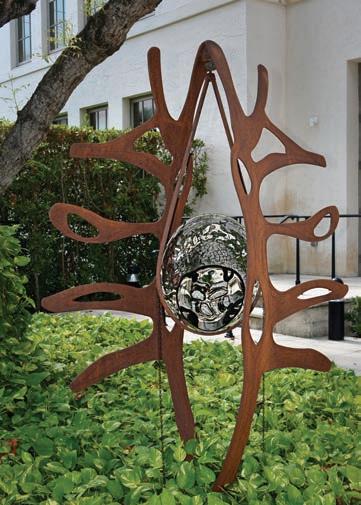
GIFT OF BOB AND TOMMIE DUKE AND BOB AND BEATRICE GUTHRIE COLLECTION OF THE SOCIETY OF THE FOUR ARTS, 2021.2
The Dixon Building boasts the John and Maureen Donnell North Terrace, a small outdoor space open during classes and events. Bob and Tommie Duke and Bob and Beatrice Guthrie donated Tree (1999), a kinetic steel and glass sculpture by Italian artist Giampaolo Seguso, to adorn the terrace. Seguso’s family has been working as glassblowers on the island of Murano for 22 generations.
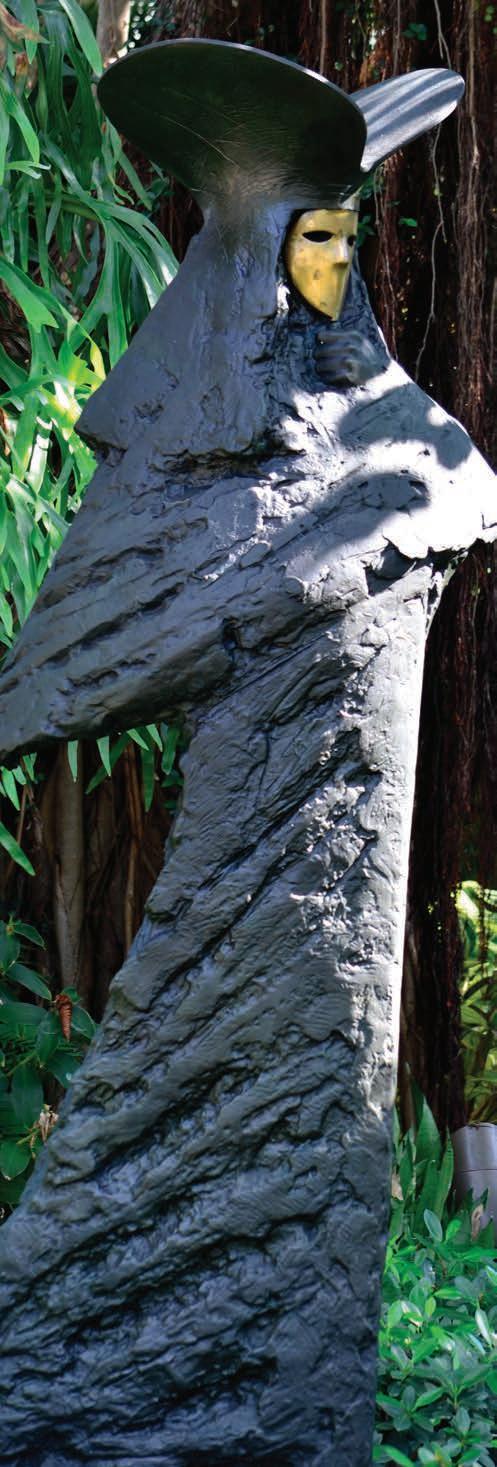
GIFT OF REGINALD B. COLLIER COLLECTION OF THE SOCIETY OF THE FOUR ARTS, 2005.2
British sculptor Philip Jackson (b. 1944) specializes in life-sized sculptures of the human form with exaggerated, elongated limbs. According to the artist, his sculptures are “essentially an impressionistic rendering of the figure.” This sculpture is from a series Jackson created in which all the figures wear masks. The series was influenced by the Venetian Carnival, an annual festival held in the former Republic of Venice and still today famous for its ornate masks (maschere). This mask, the bauta, is the most ancient and typical of them all, going back to the 13th century. The sculpture’s title of ‘Sior’ is Venetian dialect for ‘Signor’, or ‘Mister’.
GIFT OF EDITH ROBB
DIXONCOLLECTION OF THE SOCIETY OF THE FOUR ARTS, 2013.1
Grainger McKoy (b. 1947), a native of South Carolina, has carved birds “feather by feather” since he was a boy. After studying biology at Clemson University, he had an apprenticeship with bird carver Gilbert Maggioni. After mastering wood carving, McCoy learned to make castings of his wood sculptures in metal using the lost-wax method. Recovery, his first outdoor sculpture, is finely worked in every detail of its feathers. The title refers to a specific motion of a bird’s wing as it withdraws to beat another forward stroke. McKoy chose the wing of a pintail duck because it has three long feathers (the tertiary feathers) that made it possible to increase the height of the sculpture. Another version of Recovery is in the Swan Lake Irish Gardens in Sumter, South Carolina.
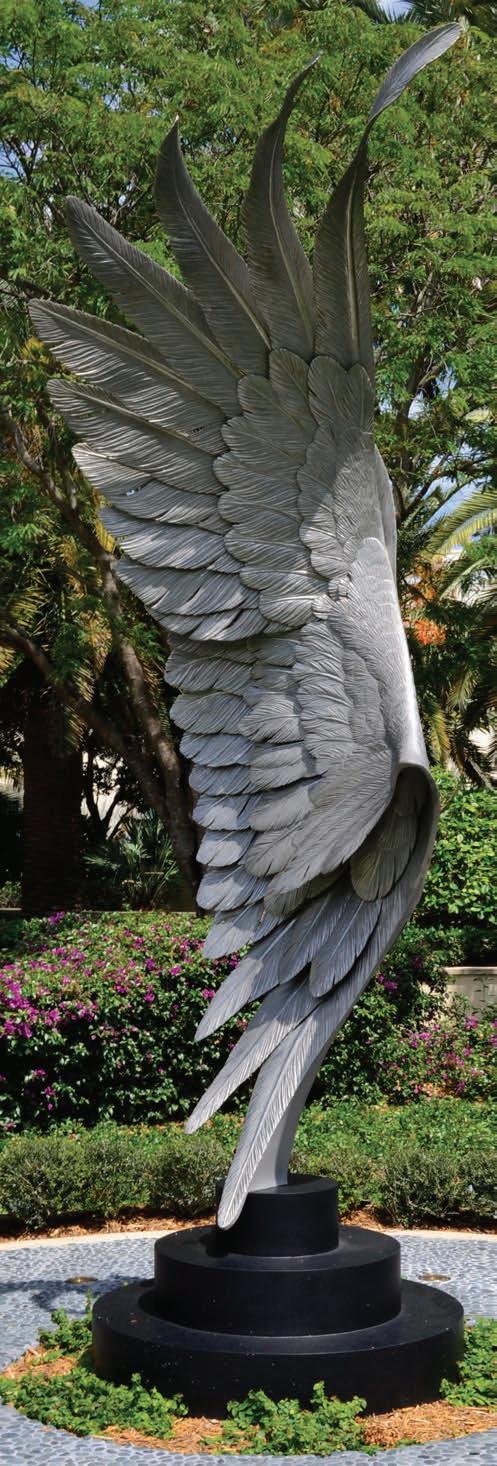
The Terrace Planters memorialize the location of a large banyan tree. After being diagnosed with an incurable fungus, the massive 100-year-old tree was removed and transported to the Bellagio Hotel and Casino in Las Vegas, Nevada where it found new life but later died. The circular planters, which were donated by Alyne Massey in memory of Jack C. Massey, reflect the circumference of the tree, which was over 80 feet tall.

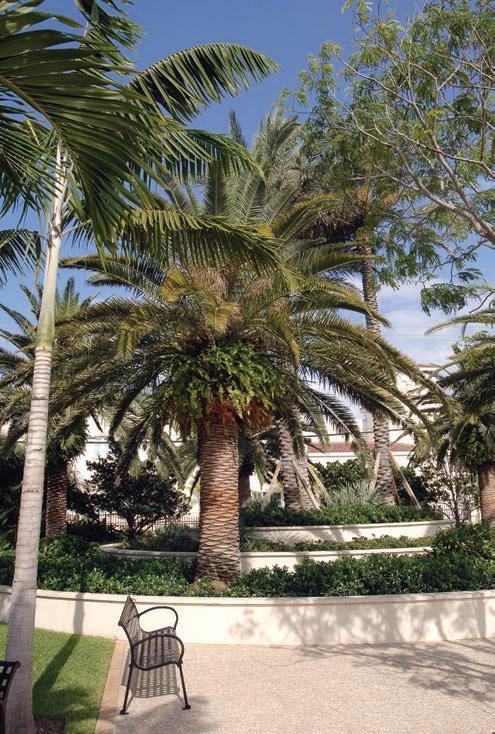
One of the main landscape features of the Sculpture Garden is the Palm Grove, which is home to a diverse selection of palm trees. This space was donated in memory of Louis Alexander Dommerich. Palm trees are one of the most recognizable features of the Florida landscape. With its warm climate and abundant rainfall, the Sunshine State is the perfect environment for these trees. However, many of the palm trees are not native and were imported from South America and Asia.
Maternidad-La Cueva, Homage to Zúñiga (Maternity-The Cave, Homage to Zúñiga), 1976 | Bronze
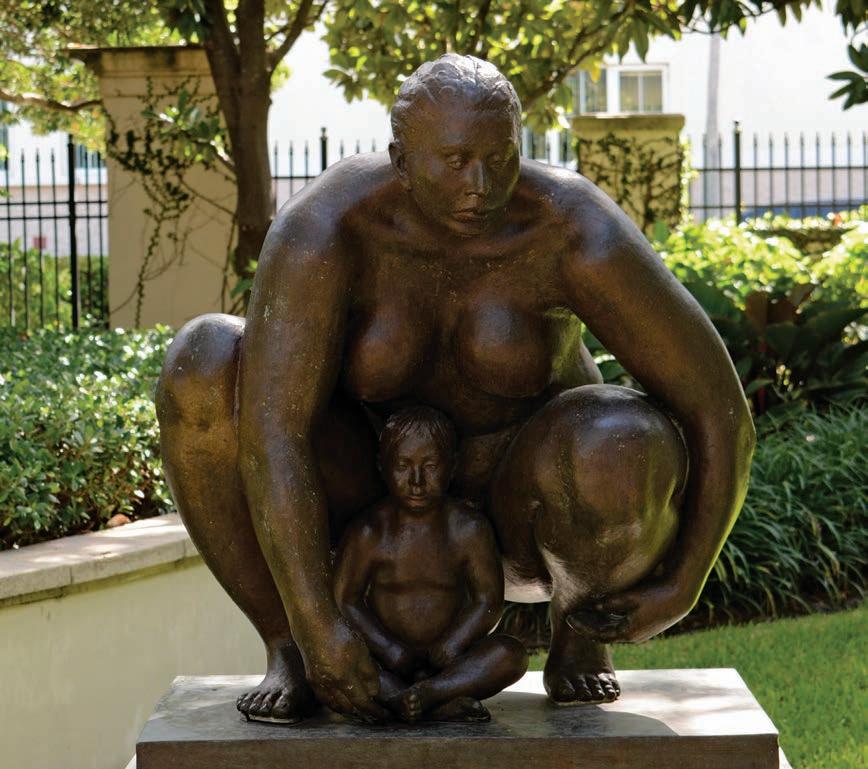
GIFT OF MRS. RICHARD HARRISON HILL, PHILIP HULITAR, AND MRS. BRADFORD A. WHITTEMORE COLLECTION OF THE SOCIETY OF THE FOUR ARTS, 1981.13
The Mexican sculptor Felipe Castañeda (b. 1933) titled this work as an homage to Francisco Zúñiga, his older contemporary, under whom he worked as a studio assistant. Within a tradition strongly influenced by pre-Columbian art, Castañeda’s figure reworks a similar crouching figure by Zúñiga. However, the addition of the sheltered child and the massiveness of the woman’s limbs and torso, emphasized by her relatively small head, make this an allegorical work, with implications of fertility and maternal devotion.
Spade (magenta), 2014

Powder-coated steel
ACQUIRED THANKS TO THE GENEROSITY OF THE CORNELIA T. BAILEY FOUNDATION COLLECTION OF THE SOCIETY OF THE FOUR ARTS, 2022.1
Michael Craig-Martin (b. Dublin, 1941), both painter and sculptor, is a major British artist. He has developed a vocabulary of imagery based on common, everyday items that probe the relationship between objects and images, perception and reality. In 2011, he began exploring the sculptural medium of powdercoated steel to create forms that appear as line drawings in the air. And their colors—vibrant shades denoted in the works’ titles, such as Spade (magenta)—have a synthetic man-made quality like that of Pop Art (and of the objects themselves). Slyly evocative in its simplicity, Spade (magenta) is suspended in the air at a grand scale that is both implausible with respect to a real garden spade and unexpected within the serene context of the Sculpture Garden.
GIFT OF KATHLEEN CHACE IN MEMORY OF FRED AND PAT SUPPER COLLECTION OF THE SOCIETY OF THE FOUR ARTS, 2019.1
This sculpture, by the Italian Gigi Supino (1893–1980), tells the story of one of Ovid’s Metamorphoses. Love stricken Apollo pursues chaste Daphne, who prays to her river-god father for deliverance and he answers her prayer by transforming her into a laurel tree. Supino’s sculpture depicts the couple just prior to Daphne’s metamorphosis, scurrying through the forest, naked in the classical Arcadian tradition. Like Wheeler Williams (Panthers in front of King Library), Supino was a successful creator of monumental sculpture in the form of war memorials, statuary, and reliefs, both allegorical and religious. The figures of Apollo and Daphne reflect the then fashionable influences of Etruscan and early classical Greek Art.

22

GIFT OF THE ARTIST COLLECTION OF THE SOCIETY OF THE FOUR ARTS, 1980.2
American sculptor Diana Guest (1909-1994) was born in England (her grandfather was Baron Wimborne) and raised there and in the U.S. and Kenya. Her mother was a member of the Phipps family, which gave the land on which the King Library was built. Guest’s sculptural practice focuses on forceful but elegant renderings of animals and plants that seem to transform from the materials themselves. She executed her works in granite, marble, alabaster, and bronze, among other materials. This fearsome sculpture’s title, Naja, refers to the genus of venomous snakes commonly called cobras.
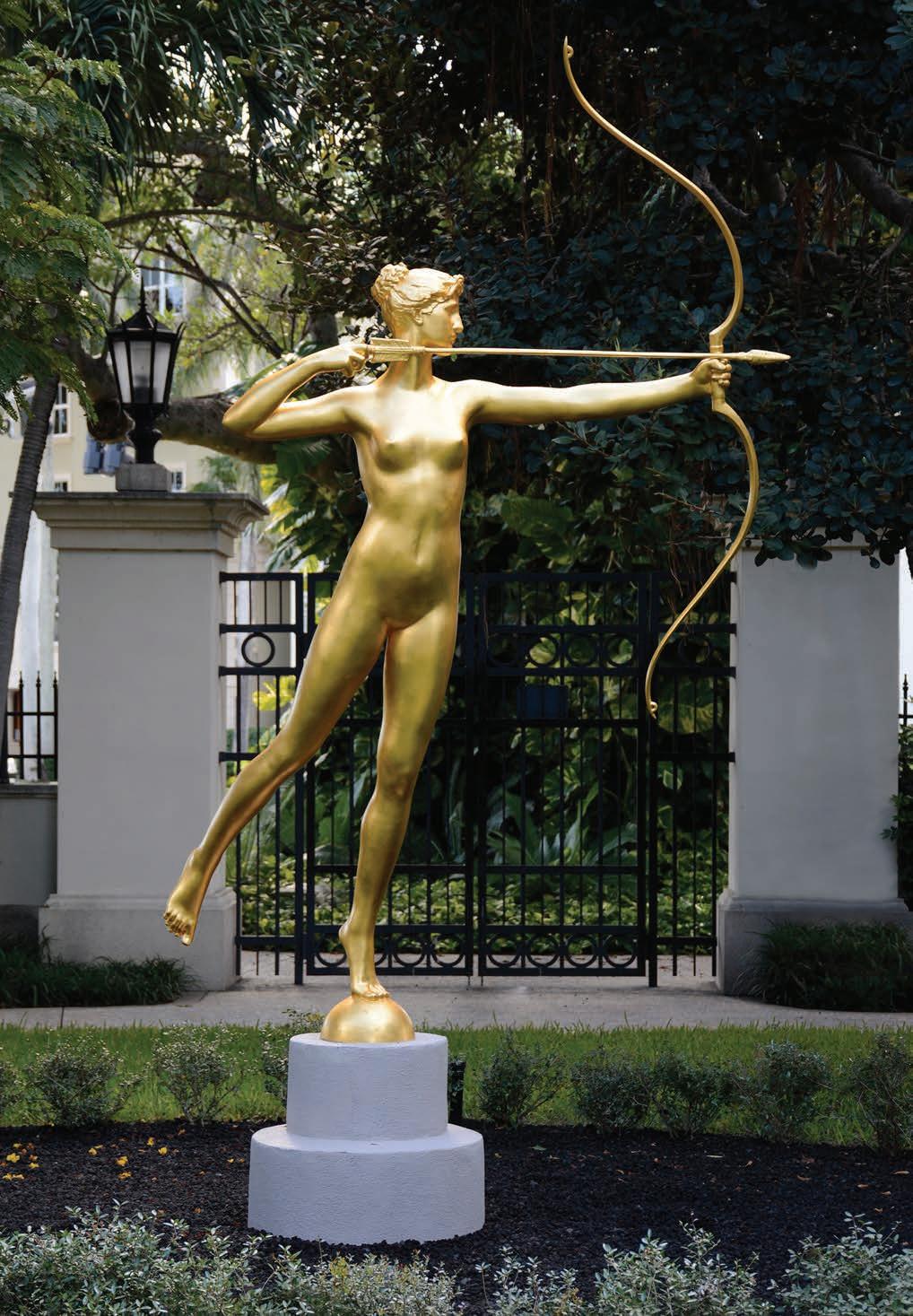
Diana, 1979 | Bronze and Gilding
GIFT OF MIRANDA AND ROBERT DONNELLEY IN HONOR OF NANCY MATO, LONGTIME VICE PRESIDENT AND CURATOR OF THE SOCIETY OF THE FOUR ARTS
COLLECTION OF THE SOCIETY OF THE FOUR ARTS, 2015.1
American sculptor Augustus Saint-Gaudens (1848–1907) is known for redirecting sculpture from a Neoclassical aesthetic to a more lively and naturalistic style. His first version of this sculpture was 18 feet tall, and was commissioned by architect Stanford White in 1891 as a weathervane for the tower of Madison Square Garden in Manhattan. A second, more graceful version, now in the Philadelphia Museum of Art, inspired a series of half-sized casts, of which this is one. Diana’s face is said to be that of Davida Johnson Clark, the mother of Saint-Gaudens’ illegitimate son Louis. Exquisitely poised, all the lithe tension of her body would be lost if she leaned only slightly back.
24
Youth, 1970 | Bronze
GIFT OF MARY AND PHILIP HULITAR
COLLECTION OF THE SOCIETY OF THE FOUR ARTS, 1980.3
Innocence, 1971 | Bronze
GIFT OF THE A. ATWATER KENT FOUNDATION
COLLECTION OF THE SOCIETY OF THE FOUR ARTS, 1980.4
The Philip Hulitar Sculpture Garden opened to the public in November of 1980, and Youth and Innocence by Mexican artist Jose Antonio Villalobos (b. 1935) were among the earliest sculptures installed.
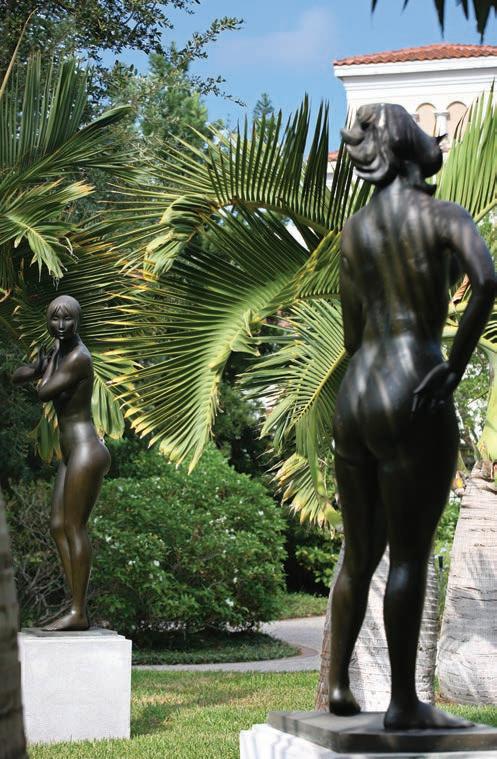
Gaston Lachaise (1882–1935) played a critical role in the birth of American modernism, pushing the boundaries of nude figuration with his innovative portrayals of the female body. He also executed a wide range of animal sculptures. Short-Tailed Peacock has a historical connection to South Florida. It was commissioned by Industrialist James Deering to decorate the gardens surrounding his estate Villa Vizcaya, now Vizcaya Museums and Gardens. After Lachaise modeled the peacock in plasticine, a plaster was made, and local craftsman carved eight stone sculptures after the plaster. The Lachaise Foundation, which was established in 1963 to perpetuate the artistic legacy of the sculptor, owns the plaster and collaborated with a foundry to have bronze castings made. This example, gilded at the comb, was made in 2017 and is the second cast in the edition.

COLLECTION OF THE SOCIETY OF THE FOUR ARTS, 1981.3
American sculptor Ira Bruce Reines (1920–1995) was a self-taught artist who began making sculptures at the age of five. His diminutive statue of Neptune, the Roman god of the sea, is installed at the end of the Mary Nell and Ralph B. Rogers Fountain. A variant of Gian Lorenzo Bernini’s Neptune and Triton (1622–23), it is in the tradition of Italian Baroque sculpture. Neptune rises from the sea on a dolphin, clutching the trident with which he causes the earth to flood in revenge for an attempt on the life of Jupiter his brother (Ovid). Later in his career, Reines developed a style he coined “Sculptural Etherealism” in which he strove to capture the spiritual processes of awakening and enlightenment in his figures.

(Artist Unknown, Franco-Flemish), ca. 1875–1900 | Lead
GIFT OF MR. AND MRS. HENRY W. BREYER COLLECTION OF THE SOCIETY OF THE FOUR ARTS, 2019.2-.3
These whimsical sculptures depict pairs of putti riding fantastical sea creatures. Putti are representations of chubby, nude male children, often with wings, that frequently appear in mythological and religious paintings and sculptures. Cast in lead, a heavy metal that is dense but also soft and malleable, they are based on sculptures decorating the Jardins d’Annevoie surrounding the Château d’Annevoie in Namur, Belgium. The sculpture on the right is a direct copy of a sculpture that served as a fountain in the extensive water gardens, the source of which is the River Rouillon.


GIFT OF MR. AND MRS. THOMAS E. HASSEN
Do you notice anything special about the walkway leading to the West Terrace? Close inspection reveals that the walkway contains colorful sea shells. The walkway is concrete, a strong building material made by mixing cement, sand, water, and in this case sea shells mined from Northeast Florida. While the ancient Egyptians used early forms of concrete, the Romans are credited with developing the cement-based concrete still used widely today.
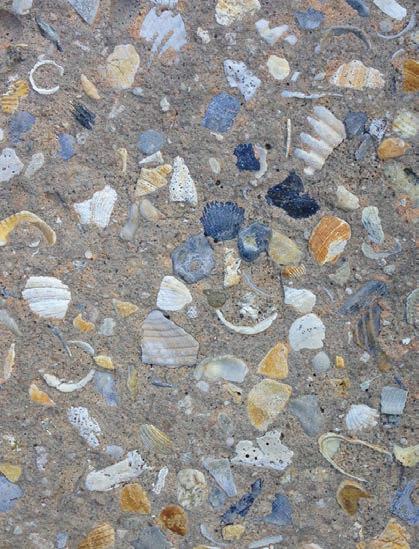
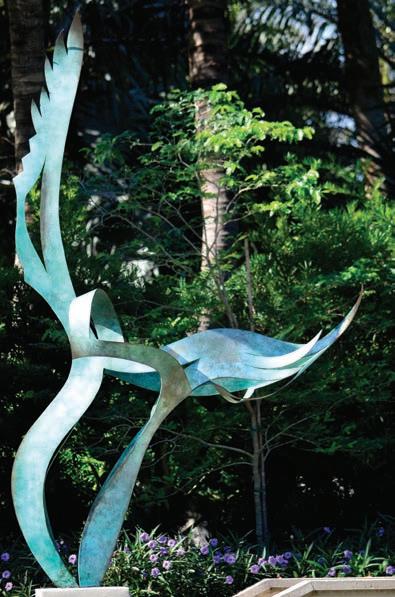
GIFT OF J. DAVID VESELSKY IN MEMORY OF FERRIS P. ELLIS AND LESLIE C. WHITE COLLECTION OF THE SOCIETY OF THE FOUR ARTS, 2009.1
John Raimondi (b. 1948), a long-time resident of Palm Beach County, created this 10-foot tall sculpture after a 60-foot version he made for the Omaha International Airport in Nebraska. Collectively they are from a series depicting endangered species. Crafted in his signature style of romantic abstraction, this statue captures cranes in flight during their ritual mating dance. The green patina, or surface coating of the sculpture, also activates the piece.
GIFT OF MR. OGDEN PHIPPS
COLLECTION OF THE SOCIETY OF THE FOUR ARTS, 1970.27
Anna Hyatt Huntington (1876–1973), who was among New York City’s most prominent sculptors in the early 20th century, was famous for her equestrian sculptures that combine vivid realism and emotional depth. The Passing of the Torch , made when the artist was in her late 70s, represents the passing of knowledge from one generation to the next as a dying man passes a torch—a symbol of knowledge—to a young man on a powerful stallion. Huntington cast this dynamic sculpture in aluminum, a lightweight material she began using in the early 1940s.

THE BUILDING IS DEDICATED TO THE MEMORY OF JOHN EDWARD ROVENSKY (1880-1970) AND DONATED BY HIS DAUGHTER, JANE R. GRACE.
Prior to completion of its first building (now the King Library), the Four Arts operated out of the Singer Building, a combined o ice and apartment building designed by Addison Mizner (18721933). Mizner’s Mediterranean Revival and Spanish Colonial Revival buildings deeply influenced the architecture of south Florida. Architect John Volk (1901-1984) renovated the building in the 1940s, after which it was called the Embassy Apartment Building. The Four Arts continued to occupy space here and eventually acquired the entire property in 1992. After renovations it, the newly named John E. Rovensky Building became home to the Four Arts’ Children’s Library and sta o ices.
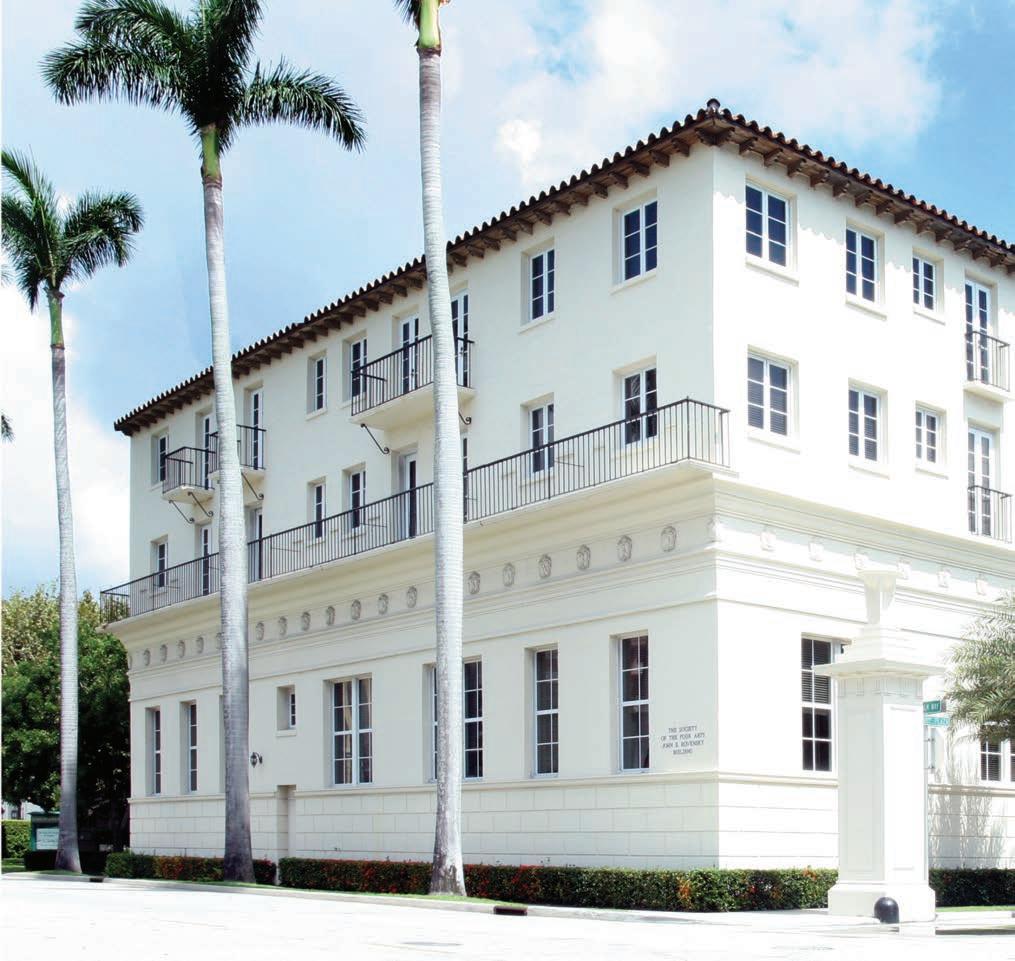
In 1947, the Four Arts purchased the Embassy Club (now the Esther B. O’Kee e Gallery Building), which was also designed by famed architect Addison Mizner. Architect John Volk transformed the Club’s open-air courtyard into a 719-seat auditorium and renovated other spaces to serve as art galleries and o ices. Today, the auditorium features state-of-the-art sound and lighting systems for concerts, lectures, films, and live-streaming events. The galleries continue to feature a diverse selection of art exhibitions. In 1995, the building was renamed for Four Arts’ member Esther B. O’Kee e as a tribute to her work as an artist. Her husband, Dr. Arthur O’Kee e, was a cousin of the American painter Georgia O’Kee e.

GIFT OF MR. AND MRS. F. WARRINGTON GILLET, JR. IN HONOR OF MR. WALTER S. GUBELMANN UPON HIS RETIREMENT AS PRESIDENT OF THE SOCIETY OF THE FOUR ARTS
COLLECTION OF THE SOCIETY OF THE FOUR ARTS, 1988.1
American artist D.H.S. “Du ” Wehle (b. 1950) is also a zoologist and environmentalist. His sculptures of various wildlife set out to capture the essence of animals in their natural state. Installed in the center of a water fountain, this sculpture creates the illusion that an Atlantic tarpon (also known as a Silver King) is jumping out of the ocean. The giants of the fish world, Atlantic tarpons can grow up up to 8 feet in length and can weigh up to 350 pounds. Despite their large size, they are one of the most aerial and acrobatic large game fish. Close inspection reveals the sculpture has two patinas: rich dark brown for the fish and green for the waves of water.

GIFT OF THE ZIUTA AND JOESPH JAMES AKSTON FOUNDATION COLLECTION OF THE SOCIETY OF THE FOUR ARTS, 1976.2
Located along the Intracoastal waterway is the monumental stainless-steel sculpture Intetra. This is the work of one of the 20th century’s most important and critically acclaimed American sculptors, Isamu Noguchi (1904–1988). Intetra is in the shape of a tetrahedron—a triangular pyramid composed of four triangular faces, six straight edges, and four vertex corners. If you peek inside the sculpture, you will notice a series of pipes that control a mist fountain. Due to mineral deposits caused by the South Florida climate, this feature had to be disconnected shortly after it was installed in the late 1970s. Conservation in 2020 restored the pattern of brushwork on the steel surfaces, which adds a pictorial dimension to the work.
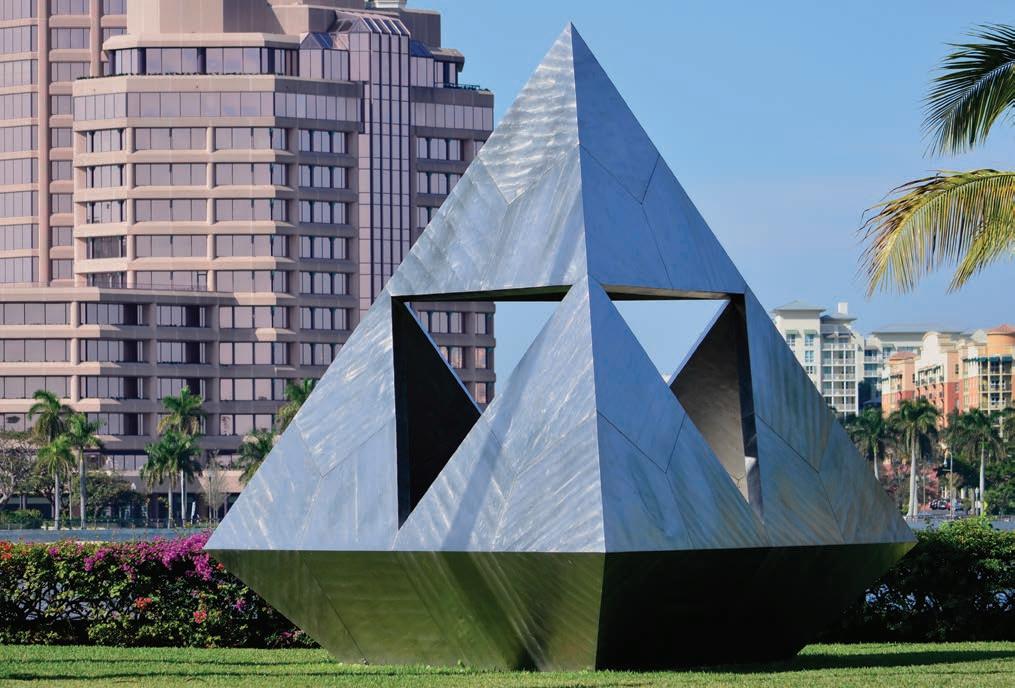
For more information, please visit www.fourarts.org


